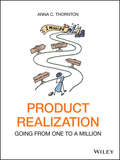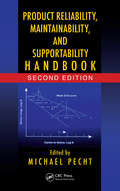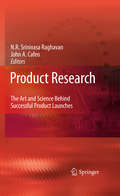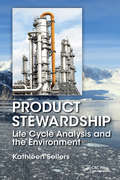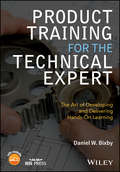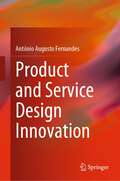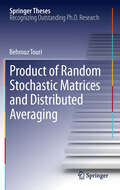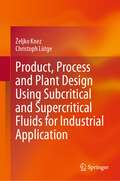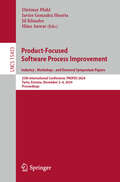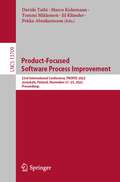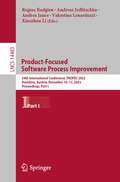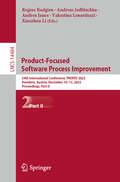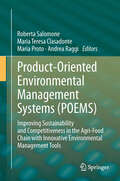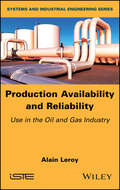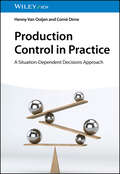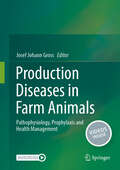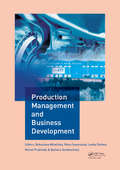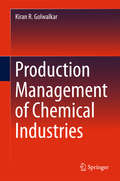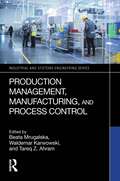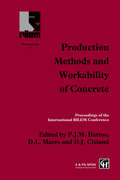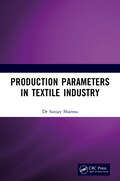- Table View
- List View
Product Realization: Going from One to a Million
by Anna C. ThorntonMost of the literature on product realization is scattered in blogs, individual chapters of books, and internal company documents. Until now, there has been no single text that covers the whole launch process from end-to-end. The challenge of product realization is the interactions between the various activities and deliverables. Product Realization is based on first-hand experience with many companies comprising different sizes, technologies, and product development timelines. This book brings together fundamental theories and product development tools with the reality of what it takes to work in industry. Includes examples and stories from industry to illustrate and bring the material alive.
Product Release Planning: Methods, Tools and Applications
by Guenther RuheBusiness success hinges on successfully creating products with the right features. You must correctly analyze the needs of the customer and match these needs with your resources to not only produce a product and but also deliver it in a timely manner. An in-depth understanding of systematic release planning can put you on this path. Authored by ren
Product Reliability, Maintainability, and Supportability Handbook
by Michael PechtCompetitive product development is all about reliability, maintainability, and supportability and the earlier that these factors are considered the better. Edited by a mechanical engineer known for his work in product development, reliability, packaging, and supply chain efficiency, this invaluable bestselling resource is now updated to include new optimization methods, as well as the IEEE standards 1332 and 1413 on reliability and reliability prediction. The text presents the latest software tools for reliability evaluation as well as emerging techniques, such as up-rating, burn-in, and screening methods. It also explores the physics of failure in design and testing and the integration of reliability with business considerations.
Product Research: The Art and Science Behind Successful Product Launches
by John A. Cafeo N. R. RaghavanThis book is a collection of research papers to be presented at the GM R&D India Science Lab workshop on Art and Science of Product Development held at Bangalore, India. Leading researchers from around the world, and from within GM, present some of their latest research and experience around methodologies and analytics that we believe, are very critical to any product development activity. This book has articles in four major pillars of product development research: a, uncertainty modeling and information integration; b, role of behavioral research in understanding customer requirements and designing products; c, advanced analytical approaches for identifying voice of the customer; and d, human centered decision making and its role in product development.
Product Stewardship: Life Cycle Analysis and the Environment
by Kathleen SellersConsider the Consequences of Bringing a Chemical to MarketProduct Stewardship: Life Cycle Analysis and the Environment explores the regulatory and scientific aspects of the life-cycle consequences of bringing a chemical to market. Using case studies to bring critical points to life, this multidisciplinary text explores the factors that influence ou
Product Training for the Technical Expert: The Art of Developing and Delivering Hands-On Learning
by Daniel W. BixbyI was pleased to review Dan's new book - pleased because he addresses an old topic in a new way. He is making no assumptions for trainers who are not fully experienced and seasoned. He takes them step-by-step through practical and realistic methods to set up training graduates to actually be on-the-job performers. Enjoy, learn and be inspired. Jim Kirkpatrick, PhD Senior Consultant, Kirkpatrick Partners, USA Daniel Bixby’s approach to Product Training for technical experts is practical, relevant and exactly what anyone who is required to train others on technical content really needs. He writes with candor and with a sense of ease, making the reader feel as though he is right there with you helping to develop your training competency. A must read for anyone on your team required to provide technical training to others! Jennifer Alfaro Chief Human Resources Officer, USA An expert guide to developing and delivering technical product training programs While there are many books on talent development, leadership training, and internal training program development, there are precious few offering subject matter experts (SME’s) guidance on training others to get the most out of their products. Written by a training expert with many years of experience working at top technology companies, Product Training for the Technical Expert fills that yawning gap in the training literature by providing technical experts with a comprehensive handbook on becoming effective product training instructors. When new technology is rapidly transformed into products for popular consumption, technical experts, such as engineers, and other subject matter experts, are the ones tasked with instructing the public on their use. Unfortunately, most them have little or no prior experience or training in adult education and don’t have a clue about how to transfer their knowledge to others. In this book, author Daniel W. Bixby draws upon his vast experience developing and delivering training programs at Honeywell, Delphax, Telex, Bosch, and TE Connectivity, among other technology companies, to arm SMEs with the knowledge and skills they need to add “Product Training Specialist” to their resumes. Addresses an area of training too often overlooked and ignored in the professional literature Equips SMEs with the tools they need to become effective product instructors Covers both the educational and business aspects of product training for SMEs Packed with tables, illustrations, problem-and-solution sets, tutorials, enlightening real-world examples, worksheets, and group or self-study questions Features a companion website with worksheets and other valuable tools: www.wiley.com/go/bixbycert A must-have professional development resource for students and experienced technical experts alike Product Training for the Technical Expert is an ideal guide forengineers, product managers, product marketing managers, and technical instructors looking to expand their repertoires and hone their skills. It also makes an excellent course text for graduate-level engineering programs.
Product and Service Design Innovation
by António Augusto FernandesThis textbook describes strategic product and service planning, introducing the concept of innovation. Linear models of product development are presented, and the product concept and system architecture generation are introduced. The responsiveness of the development process to uncertainty and complexity is covered, as well as ways of managing portfolios, programmes and projects. This textbook results from the author's experience of teaching more than 40 years. The methods described in the book have been taught and applied by the students. Examples of concept development projects of products and services carried out by the students are described, many of them revealing great creativity.
Product of Random Stochastic Matrices and Distributed Averaging
by Behrouz TouriThe thesis deals with averaging dynamics in a multiagent networked system, which is a main mechanism for diffusing the information over such networks. It arises in a wide range of applications in engineered physical networks (such as mobile communication and sensor networks), as well as social and economic networks. The thesis provides in depth study of stability and other phenomena characterizing the limiting behavior of both deterministic and random averaging dynamics. By developing new concepts, and using the tools from dynamic system theory and non-negative matrix theory, several novel fundamental results are rigorously developed. These contribute significantly to our understanding of averaging dynamics as well as to non-negative random matrix theory. The exposition, although highly rigorous and technical, is elegant and insightful, and accompanied with numerous illustrative examples, which makes this thesis work easily accessible to those just entering this field and will also be much appreciated by experts in the field.
Product, Process and Plant Design Using Subcritical and Supercritical Fluids for Industrial Application
by Christoph Lütge Željko KnezThis book describes cutting edge technology using supercritical fluids for the production of foodstuffs, medicals, and polymers. It illustrates the importance and use of basic data for design and operation at industrial scale units. The book's authors have several decades of experience of applied research on how to develop large scale industrial units. It provides readers complete insight in design and operation of industrial high pressure process plants. The book is written so it may be understood for people (with?) little or no background on high pressure process technology. It will provide information on how some foodstuffs, medicals, polymers are produced using high pressure technologies. The book demonstrates the importance of fundamental data, how to measure them and how to apply them to design industrial plants. At the same time, it also serves as a textbook for students.
Product-Focused Software Process Improvement. Industry-, Workshop-, and Doctoral Symposium Papers: 25th International Conference, PROFES 2024, Tartu, Estonia, December 2–4, 2024, Proceedings (Lecture Notes in Computer Science #15453)
by Dietmar Pfahl Jil Klünder Javier Gonzalez Huerta Hina AnwarThis book constitutes the refereed proceedings of the 25th International Conference on Product-Focused Software Process Improvement, PROFES 2024, held in Tartu, Estonia, during December 2–4, 2024. The 9 Industry papers, 2 Workshop papers, 2 Doctoral symposium papers and 1 Keynote paper presented in this volume were carefully reviewed and selected from 85 submissions. The contributions were organized in topical sections as follows: Industry Papers; Third Workshop on Engineering Processes and Practices for Quantum Software (PPQS 2024); and Doctoral Symposium Papers.
Product-Focused Software Process Improvement: 23rd International Conference, PROFES 2022, Jyväskylä, Finland, November 21–23, 2022, Proceedings (Lecture Notes in Computer Science #13709)
by Marco Kuhrmann Pekka Abrahamsson Tommi Mikkonen Jil Klünder Davide TaibiThis book constitutes the refereed proceedings of the 23rd International Conference on Product-Focused Software Process Improvement, PROFES 2022, which took place in Jyväskylä, Finland in November 2022.The 24 full technical papers, 9 short papers, and 6 poster papers presented in this volume were carefully reviewed and selected from 75 submissions. The book also contains and 8 doctoral symposium papers and 7 tutorial and workshop papers.The contributions were organized in topical sections as follows: Keynote; Cloud and AI; Empirical Studies; Process Management; Refactoring and Technical Dept; Software Business and Digital Innovation; Testing and Bug Prediction; Posters; Tutorials; Workshop on Engineering Processes and Practices for Quantum Software (PPQS’22); 1st Workshop on Computational Intelligence and Software Engineering (CISE 2022); Doctoral Symposium.
Product-Focused Software Process Improvement: 24th International Conference, PROFES 2023, Dornbirn, Austria, December 10–13, 2023, Proceedings, Part I (Lecture Notes in Computer Science #14483)
by Andrea Janes Andreas Jedlitschka Valentina Lenarduzzi Xiaozhou Li Regine KadgienThis book constitutes the refereed proceedings of the 24th International Conference on Product-Focused Software Process Improvement, PROFES 2023, which took place in Dornbirn, Austria, in December 2023. The 21 full technical papers, 8 short papers, and 1 poster paper presented in this volume were carefully reviewed and selected from 82 submissions. The book also contains one tutorial paper, 12 and workshop papers and 3 doctoral symposium papers.The contributions were organized in topical sections as follows: Part I: Software development and project management; machine learning and data science; software analysis and tools; software testing and quality assurance; security, vulnerabilities, and human factors; Part II: Posters; Tutorials; 2nd Workshop on Computational Intelligence and Software Engineering (CISE 2023); 2nd Workshop on Engineering Processes and Practices for Quantum Software (PPQS’ 23); doctoral symposium.
Product-Focused Software Process Improvement: 24th International Conference, PROFES 2023, Dornbirn, Austria, December 10–13, 2023, Proceedings, Part II (Lecture Notes in Computer Science #14484)
by Andrea Janes Andreas Jedlitschka Valentina Lenarduzzi Xiaozhou Li Regine KadgienThis book constitutes the refereed proceedings of the 24th International Conference on Product-Focused Software Process Improvement, PROFES 2023, which took place in Dornbirn, Austria, in December 2023. The 21 full technical papers, 6 industrial papers, 8 short papers and 1 poster paper were carefully reviewed and selected from 82 submissions. The book also contains one tutorial paper, 11 workshop papers and 3 doctoral symposium papers. The contributions were organized in topical sections as follows: Part I: Software development and project management; machine learning and data science; software analysis and tools; software testing and quality assurance; security, vulnerabilities, and human factors; Part II: Posters; Tutorials; 2nd Workshop on Computational Intelligence and Software Engineering (CISE 2023); 2nd Workshop on Engineering Processes and Practices for Quantum Software (PPQS’ 23); doctoral symposium.
Product-Focused Software Process Improvement: 25th International Conference, PROFES 2024, Tartu, Estonia, December 2–4, 2024, Proceedings (Lecture Notes in Computer Science #15452)
by Dietmar Pfahl Jil Klünder Javier Gonzalez Huerta Hina AnwarThis book constitutes the refereed proceedings of the 25th International Conference on Product-Focused Software Process Improvement, PROFES 2024, held in Tartu, Estonia, during December 2–4, 2024. The 18 full papers, 12 short papers, 9 Industry papers, 2 Workshop papers, 2 Doctoral symposium papers, and one Keynote paper presented in this volume were carefully reviewed and selected from 85 submissions. The main theme of PROFES 2024 was professional software process improvement (SPI) motivated by product, process, and service quality needs. The technical program of PROFES 2024 was selected by a committee of leading experts in software process improvement, software process modeling, and empirical software engineering.
Product-Oriented Environmental Management Systems (POEMS): Improving Sustainability and Competitiveness in the Agri-Food Chain with Innovative Environmental Management Tools
by Roberta Salomone Maria Teresa Clasadonte Maria Proto Andrea RaggiRepresenting the coordinated work of a research group from four different Italian University departments which conducted the Eco-Management for Food (EMAF) Project, this book offers a systematic approach for managing and improving the environmental aspects of agri-food processes and products using Product-Oriented Environmental Management Systems (POEMS).
Production Availability and Reliability: Use in the Oil and Gas industry
by Alain LeroyThe objective of the book is to provide all the elements to evaluate the performance of production availability and reliability of a system, to integrate them and to manage them in its life cycle. By the examples provided (case studies) the main target audience is that of the petroleum industries (where I spent most of my professional years). Although the greatest rigor is applied in the presentation, and justification, concepts, methods and data this book is geared towards the user.
Production Control in Practice: A Situation-Dependent Decisions Approach
by Henny Van Ooijen Corné DirneProduction Control in Practice Practice-oriented coverage of production planning and control processes for goods and services, written for any industry Production Control in Practice explores the operational control of production and inventory processes in organizations across industries, covering both tangible and intangible products and offering viable, efficient solutions to characteristic production control problems, such as what goods to produce when and how. A number of examples/stylized applications are included to help readers understand and apply the discussed concepts and theories to their own organizations. This book distinguishes between the control of production units and the control of goods flow between these units and the market and discusses various coordination and material supply control mechanisms relevant to supply chains. It also presents a typology of production situations found in practice, using a structured approach to discussing the relevant control decisions for each situation. This book is unique because (basic) control decisions are discussed for the different characteristic Decoupling Point Control and Production Unit Control situations from a holistic point of view, taking into account both mathematical considerations as well as various situational factors. Sample topics covered in Production Control in Practice include: Terminology and concepts used in production control, including complexity, uncertainty, and flexibilityTypes of release triggers, covering just-in-time versus just-in-case and push versus pull in logisticsHorizontal and vertical decomposition, and time series-related forecasting for stationary demand versus demand with trendOrder size, covering optimal batch size in case of fixed order size, relaxation of assumptions, and single period considerationsMRP systems, covering Material Requirements Planning (MRP-I) and Manufacturing Resource Planning Systems (MRP-II) With excellent coverage of the subject across different products and industries and several examples to help readers follow along, Production Control in Practice is an ideal reference for bachelor students from universities of applied sciences and academic bachelor students, as well as practitioners in related disciplines.
Production Diseases in Farm Animals: Pathophysiology, Prophylaxis and Health Management
by Josef Johann GrossThis textbook deals comprehensively with livestock production diseases and their prevention in the major species: ruminants, swine, and poultry. It gives an interdisciplinary view on pathophysiology, prophylaxis, and health management.Livestock breeding and husbandry is often accompanied by a conflict of interest between the animal´s biological requirements and economic producer needs. This conflict is increasingly gaining attention not only by producers, animal scientists, and veterinarians, but also by the public. It creates significant future challenges, which are described and addressed in this book. The main topics covered are: • the use of antimicrobials with emphasis on security and safety for producers/consumers• the impact of locomotion disorders on performance and welfare of farm animals • the interactions of gut microbiome, genetics, climate change, metabolic status and mineral homeostasis with reproduction, performance, animal health and welfare• infectious and respiratory diseases• the raising of neonatesA special section is devoted to behavioural signs indicating an impaired animal welfare. These are the basis for precision livestock farming (PLF) technology and the development of new management concepts. The present work is a valuable resource for veterinarians, students, as well as expert readers from animal and agricultural sciences, food safety and technology. Supplementary videos can be accessed online as well as directly from the print book; simply download the Springer Nature More Media App for free and scan the links with the play button.
Production Economics: Evaluating Costs of Operations in Manufacturing and Service Industries (Industrial Engineering)
by Anoop Desai Aashi MitalThis book serves a unique purpose within the world of engineering. It covers the economics of modern manufacturing and focuses on examining the techniques and methods from a cost perspective. It can be used by both students and professionals alike. The book is useful to students in industrial engineering and mechanical engineering programs as a primary textbook for engineering economy, production costing, and related courses. It can also be used by MBA students specializing in production management and finance. Specific topics of coverage include the computation of direct and indirect cost for manufacturing operations, including a variety of overhead operations in such an environment. Costing of manufacturing methods such as casting, forging, turning, milling, and welding is addressed along with inventory analysis. The book also includes fundamental concepts such as cash flow analysis, present and future worth analysis, and rate of return analysis. Related topics such as equipment replacement, comparison of alternatives, depreciation, buy versus make decisions, interest factors, and equivalence are covered in detail as well. Key Features: Addresses the costing of manufacturing operations through a step-by-step problem solving approach. Includes traditional engineering topics such as cash flow analysis, present worth, future worth analysis, replacement analysis, equivalence, and depreciation are addressed in depth as well. Offers a variety of solved examples that can be used to develop a thorough understanding of the underlying concept. Provides a number of practice problems at the end of each chapter. Presents a large number of figures and tables in almost every chapter, to assist in visualizing the concept and apply it successfully. Production Economics: Evaluating Costs of Operations in Manufacturing and Service Industries focuses on rigorous problem solving. Each topic is presented succinctly along with numerous solved examples, along with a large number of end-of-chapter practice problems where applicable.
Production Management and Business Development: Proceedings of the 6th Annual International Scientific Conference on Marketing Management, Trade, Financial and Social Aspects of Business (MTS 2018), May 17-19, 2018, Košice, Slovak Republic and Uzhhorod, Ukraine
by Bohuslava Mihalčová Editor Petra Szaryszová Editor Lenka Štofová Editor Michal Pružinský Editor Barbora Gontkovičová EditorTrends in economic development rely on increasing human knowledge, which stimulate the development of new, sophisticated technologies. With their utilization production is raised and the intent is to decrease natural resources consumption and protect and save our life environment as much as we can. At the same time, increasing pressure is observed both from competition and customers. The way to be competitive is by improving manufacturing and services offered to the customer. These are the major challenges of contemporary enterprises. Organizations are improving their activities and management processes. This is necessary to manage the seemingly intensifying competitive markets successfully. Enterprises apply business-optimizing solutions to meet new challenges and conditions. This way ensuring effective development for long-term competitiveness in a global environment. This is necessary for the implementation of qualitative changes in the industrial policy. "Process Control and Production Management" (MTS 2018) is a collection of research papers from an international authorship. The authors present case studies and empirical research, which illustrates the progressive trends in business process management and the drive to increase enterprise sustainability development.
Production Management and Engineering Sciences: Proceedings of the International Conference on Engineering Science and Production Management (ESPM 2015), Tatranské Matliare, High Tatras Mountains, Slovak Republic, 16th-17th April 2015
by Milan Majerník Naqib Daneshjo Martin BosákThese are the proceedings of the International Conference on Engineering Science and Production Management, 16th � 17th April 2015, Tatransk�trba, High Tatras Mountains - Slovak Republic . The proceedings contain articles focusing on:- Production Management, Logistics- Industrial development, sustainable production- Planning, management and pr
Production Management of Chemical Industries
by Kiran R. GolwalkarThis book covers all major areas of operation, pollution control, safety, modernization, diversification, and resource management for cost control in the industrial production of chemicals. The author details the importance of obtaining the right type of raw materials and equipment for maximum plant efficiency and discusses revival of plants that have been idle for long periods. He also presents important issues concerning product quality, energy recovery, safety, pollution control and improving profitability by proper management of resources. The book is ideal for shop floor engineers, middle level management, and owners of small- and medium-scale facilities in many countries as it serves as a guide for keeping the plant operations running in adverse situations, for reducing energy consumption; improving profitability, resource allocation, and workforce planning.
Production Management, Manufacturing, and Process Control: Proceedings Of The Ahfe 2019 International Conference On Human Aspects Of Advanced Manufacturing, And The Ahfe International Conference On Advanced Production Management And Process Control, July 24-28, 2019, Washington D. C. , Usa (Industrial and Systems Engineering Series #971)
by Waldemar Karwowski Beata Mrugalska Tareq Z. AhramDrawing on contributions from various manufacturing fields, this book offers a comprehensive perspective by combining theoretical concepts with practical applications. It emphasizes future developments, the integration of technologies, and the crucial role of humans in manufacturing companies.Production Management, Manufacturing, and Process Control presents cutting-edge strategies and innovations for creating people-centered manufacturing processes. It explores how culture influences cognition and behavior, providing readers with valuable insights into relevant theories. This book also explores risk management, human performance improvement, and the current challenges in quality and information systems management. Sustainable global manufacturing practices that balance global market access with strong domestic engineering ecosystems are covered in detail, and this book also addresses the optimization of production processes, including the use of machine learning for fault diagnosis.This is an ideal read and a valuable resource for students, graduates, teachers, researchers, and professionals in industrial management, business management, safety fields, manufacturing, risk management, and quality management.
Production Methods and Workability of Concrete
by P.J.M. Bartos D. L. Marrs D. J. ClelandPractical production of ordinary and special, high performance concretes and their behaviour and properties when fresh are the main themes of this book. It derives from the International RILEM Conference held in Paisley, Scotland in June 1996, and represents the culmination of the work of two RILEM Technical Committees (145 WSM Workability of Speci
Production Parameters in Textile Industry
by Sanjay SharmaThis book details the various production parameters in the textile industry and discusses their influence and interaction. It also includes several examples to cover the estimation and effects of these parameters. The subject matter of this book also discusses: Economic batch quantity Inclusion of stock outs Interaction of production cost with other parameters Importance of cycle time Variation of K triggered by change in other parameters This book is aimed at engineers, M.Tech./MBA students, and other professionals interested in learning about production and manufacturing.Print edition not for sale in South Asia (India, Sri Lanka, Nepal, Bangladesh, Pakistan or Bhutan)
